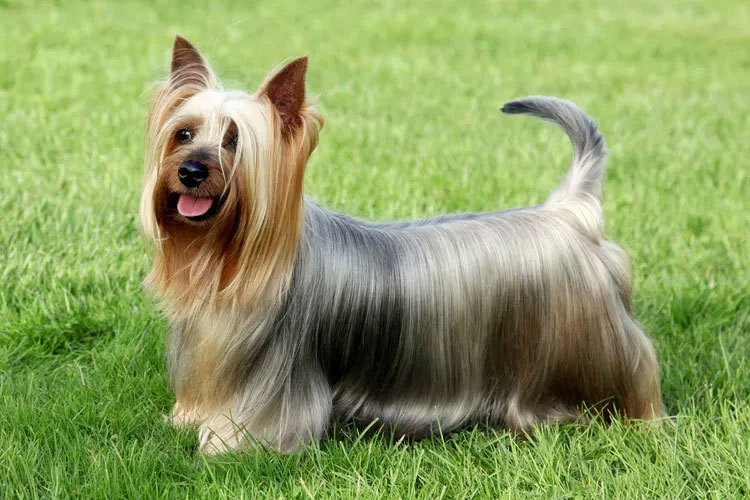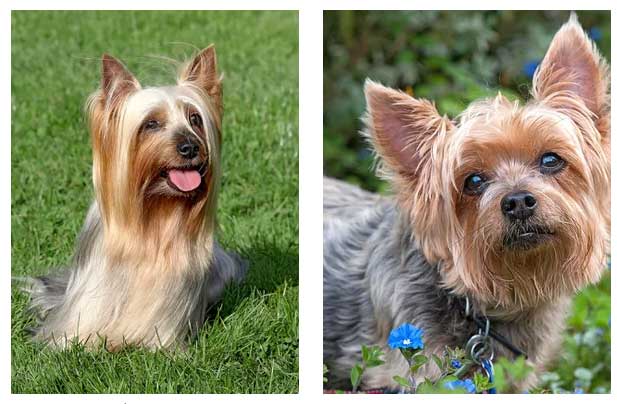
Silky Terrier Overview
| OFFICIAL NAME | Silky Terrier |
| COMMON NAME | Silky Terrier |
| PET HEIGHT | 9 to 10 inches |
| PET WEIGHT | 8 to 10 pounds |
| LIFESPAN | 13 to 15 years |
| GOOD WITH | children, families, seniors |
| TEMPERAMENT | anxious, friendly, willful |
| INTELLIGENCE | high |
| SHEDDING AMOUNT | infrequent |
| EXERCISE NEEDS | medium |
| ENERGY LEVEL | active |
| VOCAL LEVEL | frequent |
| DROOL AMOUNT | low |
| BREED GROUP | toy |
| BREED SIZE | small (0-25 lbs.) |
| COAT LENGTH | long |
| COLORS | blue, fawn |
| PATTERNS | blue and tan |
| OTHER TRAITS | apartment-friendly, good hiking companion, high prey drive, hypoallergenic |
The silky terrier (also called "silkies" for short) is a rare breed in the United States. These small dogs are instantly identifiable by their sleek coats that, just as their name suggests, are silky to the touch. That silky fur makes them a good breed for someone with allergies because their human-like hair doesn't shed much (though it's important to know no dog is truly hypoallergenic).
Those who raise silky terriers fall in love with their curious, funny, and clever personalities. If you're willing to put in time training and socializing your silky terrier (they can be a little nervous and shy) then this small, low-dander dog could be a perfect fit for you.
Appearance
The silky terrier is small in stature, but owners often say they have the personality of a large dog. Silkies measure just 10 inches at their tallest and weigh between 8–10 pounds, which makes them the perfect pup for an on-the-go lifestyle. Never one to shy away from an adventure, the silky terrier loves to accompany owners on every activity from road trips to hiking.Silky terriers are known for their straight, glossy manes that can be kept long or short, depending on the owner's preference. Their coats are a stunning color combo; their faces a rich tan and their body and hindquarters a silvery shade of blue. While their signature hairdo may seem intimidating at a glance, the silky terrier's coat is actually easy to maintain with regular brushing.

Tarianne Terrazas Quintana, a member of the Silky Terrier Club of America (STCA) board of directors, hopes more people will get to know the silky and realize that they make a great family dog or companion dog for individuals with an on-the-go lifestyle.
"It can be off-putting to people when they see the long flowing coat, but this is a sturdy, wonderful family dog," Quintana says. "I would love to see more people fall in love with this breed because they are wonderful."
Temperament
The silky terrier is a bright, active dog who can appreciate hanging out at home with her owners as much as a hike in the woods. This toy breed carries a stereotypical terrier temperament: They often have strong-willed personalities and are dedicated to their loved ones.
As highly intelligent pups, a silky often thinks of herself as a one-dog neighborhood watch—so package deliverers should beware her mighty bark. Donna Hitz, a member of the STCA board of directors, says silkies are good at alerting their owners to any visitors or animals (including the occasional scampering squirrel) that approach the house. Owners can train their silky terrier to minimize unnecessary barking but need to know it's a part of their nature.
"You need to work with them; they are smart, but they have a terrier temperament," Hitz says. "Remember that they are a 100-pound dog in a 10-pound body … There is not going to be a person who comes to my door or a moose in my yard that they will not warn me about."
Sandy Mesmer, another member of the STCA board of directors who has trained silky terriers, says it is important to be patient with your silky. Silkies often want to learn on their own schedule, and they are selective with who they choose to give their obedience to.
"I don't even look at it as [willfulness]," Mesmer says. "It's that silkies want to be your partner, and what they think has value as well. They were bred to be independent workers, so that is their hard-wiring."
Potential owners should be prepared for positive reinforcement training and consistent short training activities to engage their silky.
Living Needs
As a highly curious dog, the silky terrier craves adventure and engagement. With her short stature, she lives well in apartments and other small homes—but owners should be prepared for daily walks year-round and other forms of stimulation, such as interactive toys and playing games. Many silky terriers excel at agility work or earthdog trials, which are scent competitions for dogs originally bred to hunt rats or other vermin.Above all else, the silky is happiest when she is entertaining her chosen people. Her desire to be the center of attention can mean your silky might get jealous of other dogs or pets who steal her spotlight. In order to combat this envious streak, it is important to socialize your silky terrier puppy well.
Like many terriers, the silky can suffer from separation anxiety and should not be left at home alone for long periods of time. If her nervousness is left unaddressed, the silky can express her frustration with loud barking. Silkies prefer exploration, and they would rather accompany you on outings or errands than be left behind. Thankfully, Hitz says the silky is easy to take on any type of trip.

"They're small and they're easy to take with you, even on a plane," Hitz says. "We take ours with us all the time anytime we travel. They're so adaptable. I am so glad it's the breed that I got involved in so many years ago because it has just been entertaining, comforting, and fun. Silkies are a great dog breed."
Care
Ready for the open secret of the silky terrier world? It's actually not too tricky to get that sleek coat to shine at home! Mesmer says the silky terrier is among the easiest straight-coated dogs to groom, as long as owners are willing to keep up with weekly baths and brushing sessions. A natural bristle dog brush or a rubber comb can keep a silky terrier looking her best."It's surprising because you'd think with that long hair that that would be a lot of work," Messmer says. "But a good silky just needs a bath and a brush once a week."

The Silky Terrier Club of America advises owners to use a moisturizing shampoo and a detangling leave-in conditioner to clean their pup. You might even be able to use your own—because the silky terrier's coat is similar enough to human hair, human products can safely be used. And just like us, the silky can also get split ends, so make sure they get regular coat trims to avoid hair breakage.
Silky terriers also need their teeth brushed regularly, their nails kept short, and their ears occasionally checked and cleaned.
In addition to regular grooming, owners should prepare to walk their silky every day and put in time with positive reinforcement training to ensure she doesn't bark unnecessarily or chase other animals. Terriers in particular are prone to take off after squirrels and chipmunks, since they were bred to do exactly that. But Quintana says that with simple obedience training (think: the "leave it" cue), a silky terrier can be taught to control those instincts.
"If you have a cat or other animals, you just need to make sure your silky terrier knows the rules," Quintana says. "They are smart, and once you lay the rules out, they definitely remember. They have very long memories."
Health
The silky terrier boasts a reputation for being an especially healthy breed with a long lifespan of 13–15 years. Regardless of their good health, owners will want to watch for the standard issues that toy breeds can encounter. One potential issue includes hypothyroidism, a condition where a dog has an underactive thyroid gland and can experience unexplained weight gain or lethargic behavior.The most significant challenge for aspiring silky terrier owners may be finding a purebred dog in the first place. Because the silky terrier is a relatively rare breed in the U.S., people should be especially diligent about working with a reputable breeder who is dedicated to producing healthy litters.
Silky terrier breeders should always be willing to share the results of health screenings recommended by the Orthopedic Foundation for Animals, including an eye examination and evaluation for luxating patella.
People who are interested in silky terriers can look for dogs on the breeder resource page offered by the Silky Terrier Club of America, or search the Silky Terrier Rescue. Messmer also recommends interested owners apply to join Facebook groups that are run by members of the breed club: Friends of the Silky Terrier Club of America or Silky Friends.
"We find that people want puppies very, very badly," Messmer says. "One of the things that we do at Silky Friends is we have a service where you can put your name down, and then when breeders have puppies, they can contact you. We're very rigorous as to who can be in the group."

History
The silky terrier was originally bred to hunt rats and mice on farms. Their high prey drive and compact size made them perfect for flushing out vermin and keeping pests away from working communities. The silky's genetic predisposition for hunting small animals makes it important that owners keep them on-leash during outdoor excursions.Silky terriers originated as a crossbreed between Australian terriers and Yorkshire terriers in the late 1800s, according to the STCA. Even with their signature coat, silky terriers are often the victim of mistaken identity and are frequently assumed to be their more popular cousin, the Yorkie. But there are distinctions between the three breeds: Silkies are larger than Yorkies but smaller than the Australian terrier.
The terriers came to the U.S. in the 1930s, and they were officially recognized by the American Kennel Club in 1959.
Fun Facts
The silky terrier is a native of Sydney, Australia. She joins other highly active Australian dogs that made their way to the U.S., including the Australian cattle dog.Originally named the Sydney silky terrier, the breed's name was officially changed in 1955.
"Glee" actor and dancer Harry Shum Jr. is the proud owner of a silky terrier and Westie mix named Charlie.